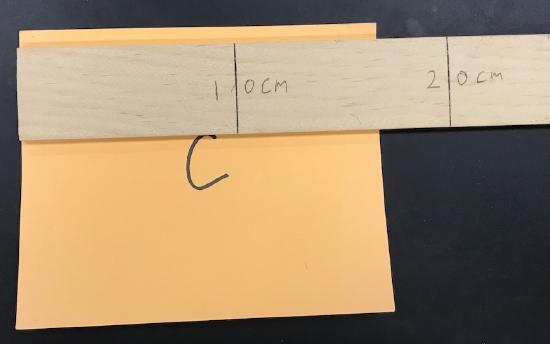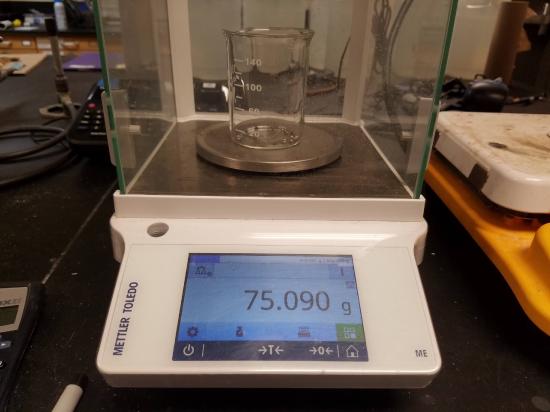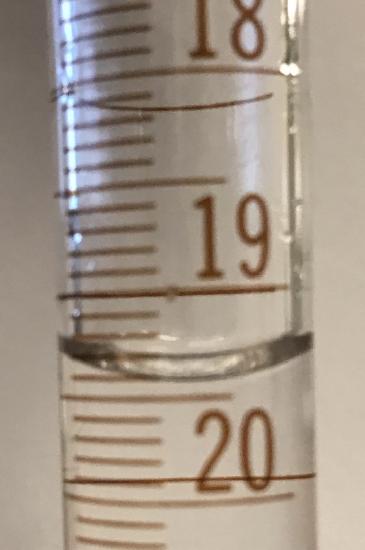Module 1 Practice
- Page ID
- 238013
Exact and Measured Numbers
Exercise \(\PageIndex{1}\)
Tell whether each number represents an exact number or an uncertain, measured number.
I have 12 coins.
- Answer
-
Exact
The total mass of my coins is 27.420 g.
- Answer
-
Uncertain (measured)
The average mass of each coin is therefore 2.2850 g per coin.
- Answer
-
Uncertain (measured)
One of the metals used to make the coins is nickel, which has a density of 8.908 g/cm3.
- Answer
-
Uncertain (measured)
The prefix "kilo" means 1000, so there are 1000 g in a kg.
- Answer
-
Exact
That means the total mass of my coins is 0.027420 kg.
- Answer
-
Uncertain (measured)
Measurement
Exercise \(\PageIndex{1}\)
What measurement should you record for the paper below using the ruler shown?

- Hint
-
The lines are every ten cm. You should record to the one cm.
- Answer
-
17 cm. (If you put 16 cm or 18 cm, that is also acceptable.)
Exercise \(\PageIndex{1}\)
What mass should you record for the beaker using the balance below?

- Answer
-
75.090 g. Use all digits given by a digital instrument. Do not round off or add more.
Exercise \(\PageIndex{1}\)
What measurement should you put for the liquid level below:
a) if you believe the liquid level is just below the line?
b) if you believe the liquid level is right on the line?
Remember to read the bottom of the meniscus (curve). The units are mL.

- Hint
-
The lines are every 0.1 mL (even though numbers are every mL). You should record to the 0.01 mL.
- Answer a
-
19.41 mL or 19.42 mL.
- Answer b
-
19.40 mL (two past the decimal, just like answer a)
Significant Digits
Exercise \(\PageIndex{1}\)
Tell the number of significant digits in each measurement.
(a) 0.00760 kg
(b) 470.80 mL
(c) 80500 cm
- Answer (a)
-
3 SD
- Answer (b)
-
5 SD
- Answer (c)
-
3 SD
Exercise \(\PageIndex{1}\)
Round each measurement to 4 significant digits.
(d) 78043.7 m
(e) 0.042268 km
(f) 5.07038 g
(g) 120.677 g
- Answer (d)
-
78040 m
- Answer (e)
-
0.04227 km
- Answer (f)
-
5.070 g
- Answer (g)
-
120.7 g
Dimensional Analysis (conversions)
Exercise \(\PageIndex{1}\)
Convert \(\dfrac{26.82 ft}{s}\) to \(\dfrac{mi}{h}\). There are 5280 feet in a mile (defined, exact relationship).
- Answer
-
\(\dfrac{18.29 mi}{h}\).
Exercise \(\PageIndex{1}\)
Given the relationships provided below, how many tablespoons (tbsp) are in 3.46 quarts (qt)?
1 tbsp = 14.787 mL
1 qt = 946.35 mL
- Answer
-
221 tbsp
Metric Conversions
Exercise \(\PageIndex{1}\)
How many \(\mu\)g are in 78.4 fg?
- Answer
-
\(7.84\times 10^{-8} \mu g\)
Exercise \(\PageIndex{1}\)
How many mg are in 0.00567 Gg?
- Answer
-
\(5.67\times 10^9 mg\) or 5,670,000,000 mg

